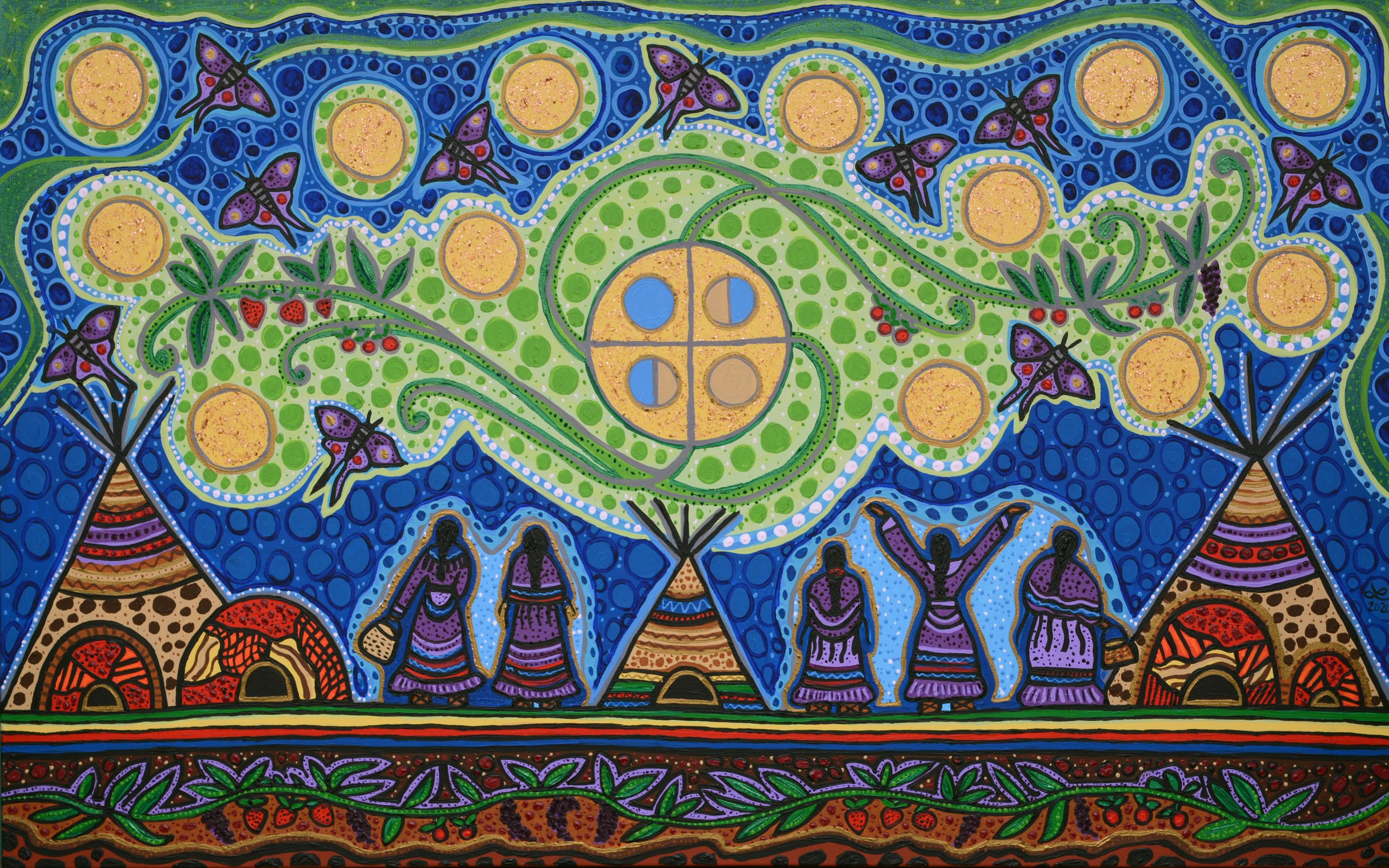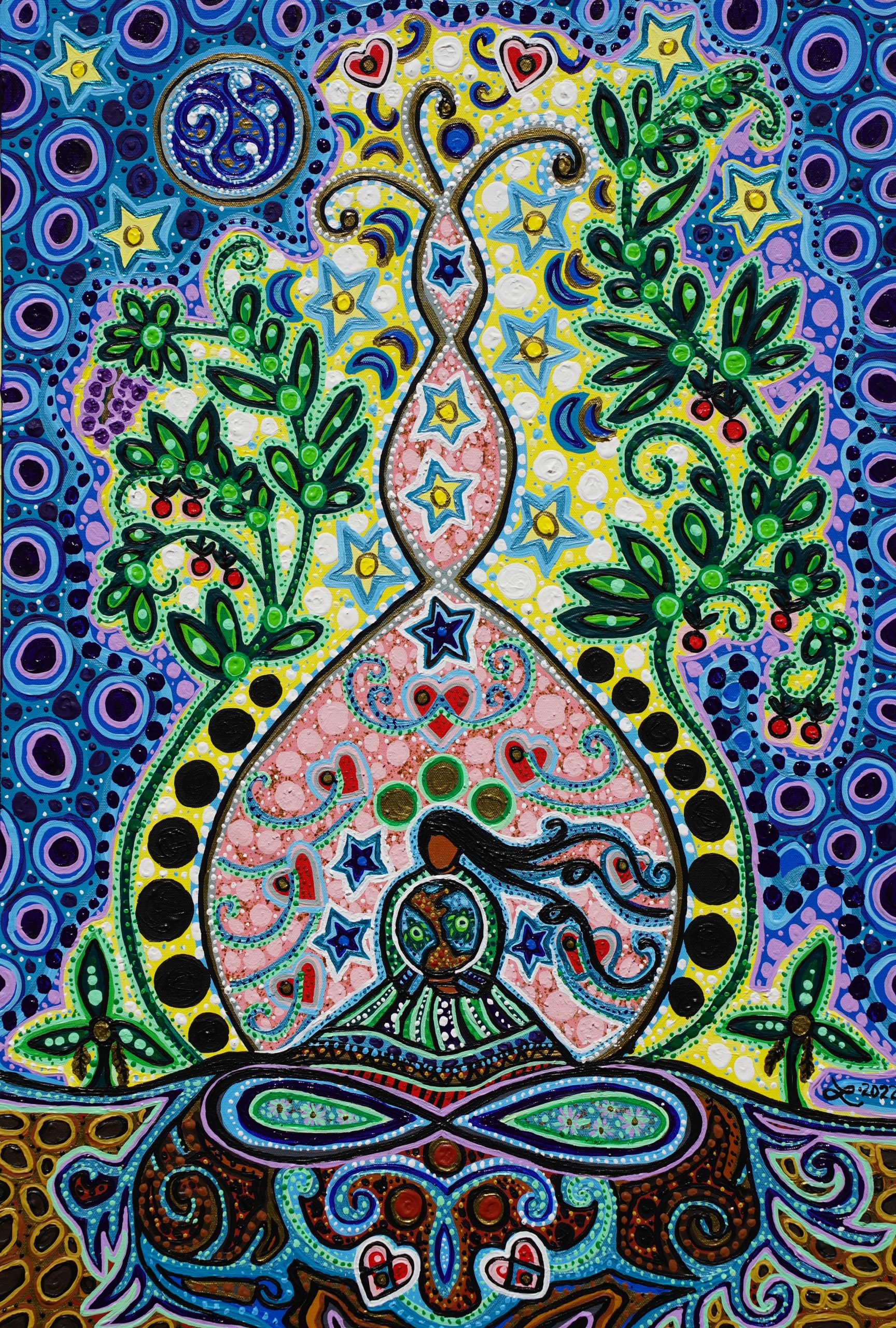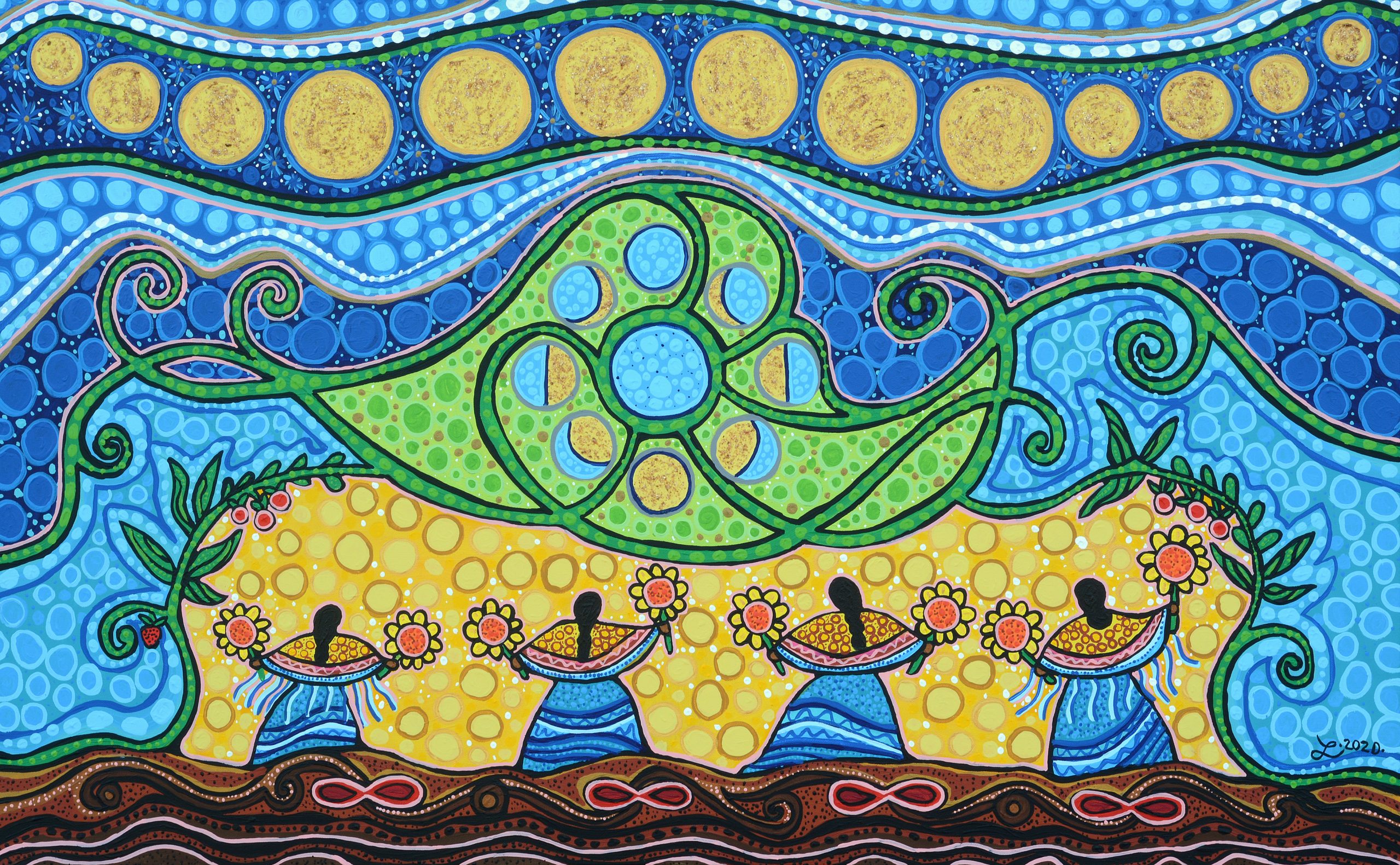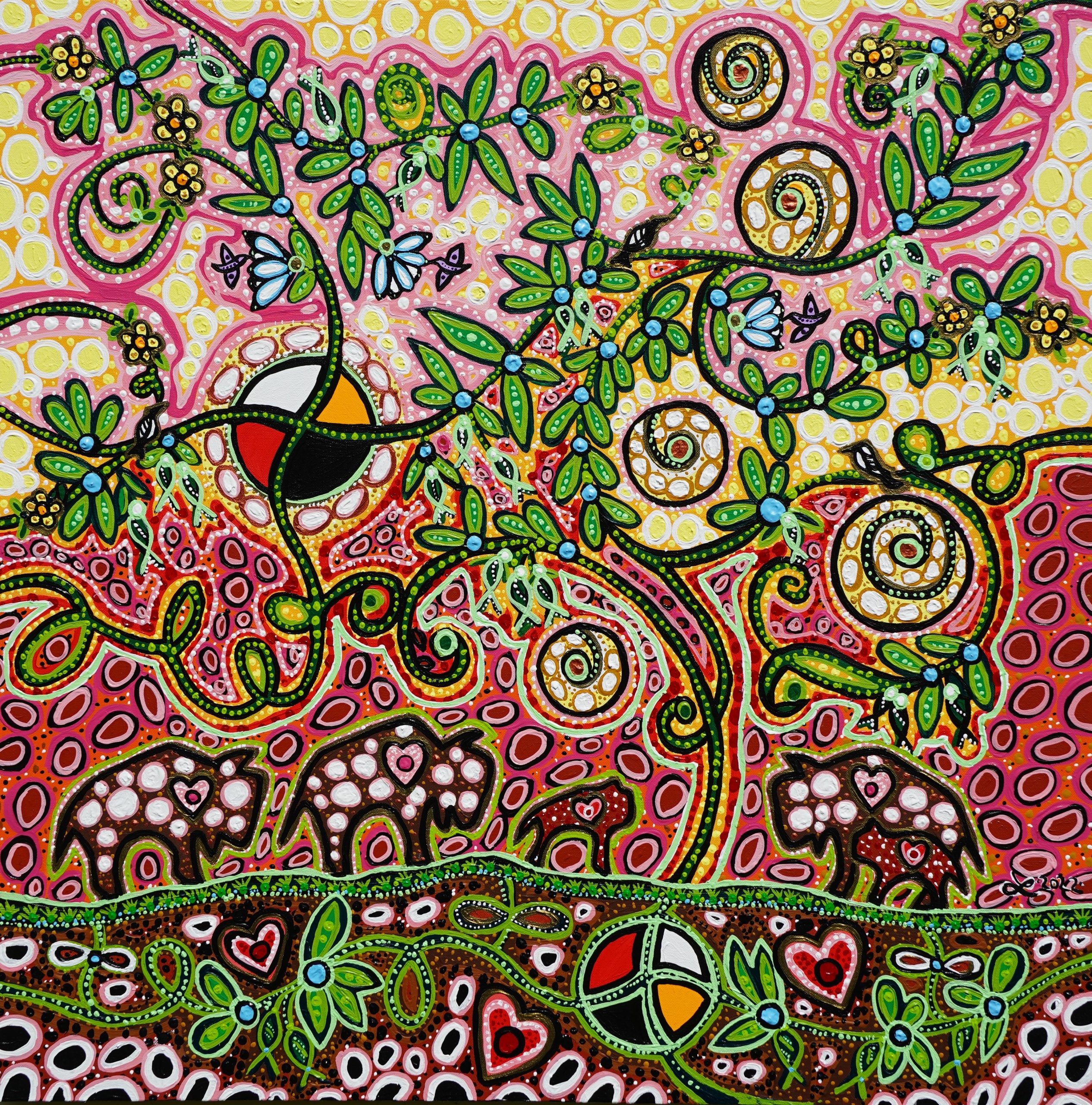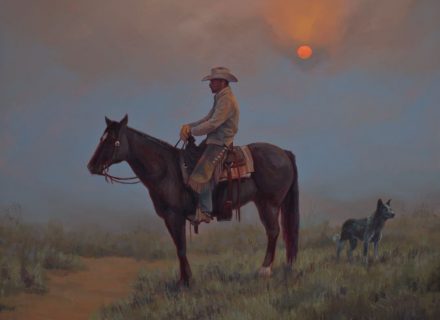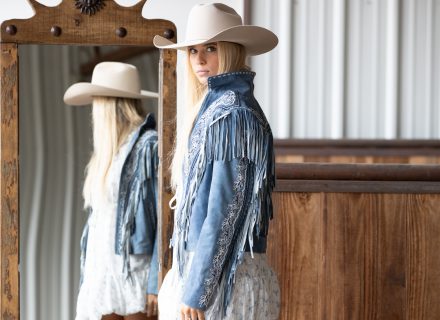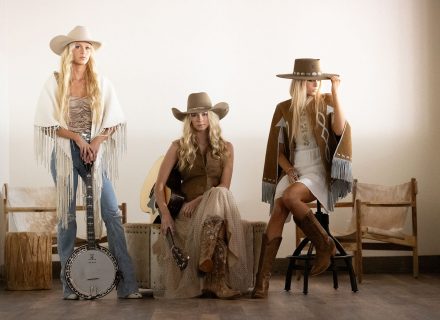The Métis artist imbues her vibrant storytelling paintings with purpose and intention to “create the world you want to live in.”
Leah Dorion is an interdisciplinary Métis artist whose work ranges from illustrating children’s book to constructing rock effigy labyrinths to teaching workshops on making moss bags and Plains-style ribbon skirts. Whatever her medium, there’s the underlying message: Creativity is a powerful tool for celebrating and understanding who the Métis people are — especially First Nations women.
From Prince Albert, Saskatchewan, Dorion creates vibrant and symbolic paintings that honor the spiritual strength of Indigenous women and the “sacred feminine.” Incorporating beads, birch bark, river rock, and shells, she shares her Métis heritage through colorful and tactile contemporary works. One such project is the Seeds From the Sacred Feminine wisdom deck — 52 cards of “gentle, land-based teachings ... to help you become more comfortable in the quiet, mysterious realms of the Sacred Feminine” — which she recently collaborated on with Vancouver, Canada-based Métis singer-songwriter, actor, and writer Andrea Menard in support of the Clan Mothers Healing Village.
A community leader in the Métis arts community always engaged in something that benefits others, Dorion was recognized last year with the Jim Brady Memorial Medal of Excellence for 2023, named for the Saskatchewan Métis leader and activist for Métis rights. Dorion is also a storyteller and children’s book author and illustrator; The Giving Tree: A Retelling of a Traditional Métis Story, Métis and Dandelions, and more recently the Mother Earth Colouring and Activity Book are some of her titles.
Dorion strongly believes that women play a key role in passing on vital knowledge for all of humanity and that they are the first teachers for the next generation. “For me, art is a spiritual expression, and my paintings are influenced by traditional cultural teachings such as the medicine wheel and the sacred circle of life,” she says. “I find that balance and harmony along with the four sacred elements of life of earth, air, fire, and water are foundational aspects of my work.”
As is the sacred feminine. As a Métis woman, Dorion feels there hasn’t been much Métis art available from the female perspective. The patterns and colors in her work derive from nature and her people, especially the way her female ancestors sewed their clothing. “Our beadwork and fur trim are now being featured in more contemporary ways,” she says. “I pull from the colorful beaded vests and gauntlets of the past to embellish and enhance my work. This connects the past and future in a really fun and meaningful way.”
And it’s much more than the visual she wants to convey. For Dorion, mothers, including Mother Earth, play a key role in passing on vital cultural knowledge for her tribe and all of humanity and are the first teachers of the next generation. “If I am going to make a long-term impact, my children’s books are the heart and soul of my work,” she says. “If I can touch children and instill these stories in them from the Métis point of view, we will continue to move forward.”
Higher education has been instrumental in that effort. “A formal university education helped me to get acceptance into the art world,” says Dorion, who earned a bachelor of education and a bachelor of arts from the University of Saskatchewan and a master of arts from Athabasca University. “I love the blending of both worlds — the oral education from the Métis community and the university academic/literacy community.” Both, she says, have made her a better artist and communicator and facilitated her role as a female storyteller and culture-keeper.
C&I talked with Dorion from her home in Saskatchewan.
C&I: What are you working on right now?
Leah Dorion: I am currently illustrating children’s books with Red Deer Press. Métis Nation of British Columbia is working with me to make Métis early years resources for Métis children and families.
C&I: Where is your workspace? What’s it like?
Dorion: I work out of my home studio near the city of Prince Albert, Saskatchewan, Canada. Out my window is a view of my pond and a large hay field — a typical central Saskatchewan scene. I love living in the country and being in my ancestral homeland making Métis style artworks.
C&I: Where do you find your inspiration?
Dorion: Mother Earth is my muse. Her artistry is beyond compare and comprehension. I try to honor her beauty in many of my artworks.
C&I: What was life like when you were growing up?
Dorion: I have always grown up near the North Saskatchewan River. The river has influenced both my identity and artwork.
C&I: When and how did you first show an inclination toward art?
Dorion: As a child I was encouraged to be creative. This type of support gave me the confidence to use my imagination. Both my parents were creative, so they role-modeled creative processes. My father was a carpenter, so I watched him and my mother, who was more of a home-design person, make beautiful items together. My father constructed many of our family homes.
C&I: What is your process?
Dorion: I love free drawing and sketching as a way to refine my ideas. And then I paint using acrylic on canvas.
C&I: You don’t just stay in your studio drawing and painting. Some of your work is outdoors and very physically engaged and quite community-centered. Tell us a little about your Willow Walking Paths.
Dorion: The willow projects are another way to connect through art and nature. Traditionally, willow has multiple uses in Métis culture, from medicine to building materials. As part of my artist residency at Mann Art Gallery in Saskatchewan, I designed a walkway using the S-curve shape of the Métis infinity symbol. The main idea was to use a traditional species and bring it into a contemporary art form. For this project, we harvested about 200 willow trees and had offerings and prayers before cutting any of them down. All of the plant materials were treated with respect and honor. After deinstallation, the willow was used for ceremonial purposes.
C&I: What a meaningful and beautiful way to invite people to experience your culture. What else would you really like people to understand about the Métis and Métis culture?
Dorion: We are an important people in the formation of Canada. We are still here today and have much to offer our world in relationship to our story, creativity, and cultural knowledge.
Leah Dorion is currently partnering with the Mann Art Gallery in Prince Albert, Saskatchewan as an artist-in-residence in a multiyear initiative to create Métis-style programs and workshops. Her work will be on view at the Wanuskewin Collective Gallery March 1–May 31 in Saskatoon, Saskatchewan, in a show featuring the original artwork for the illustrations from her children’s book Waci! Dance!, written by Sage Speidel. For more information, visit leahdorion.ca, mannartgallery.ca, and wanuskewin.com.
From our April 2024 issue.
HEADER IMAGE: Free Spirit #2.







